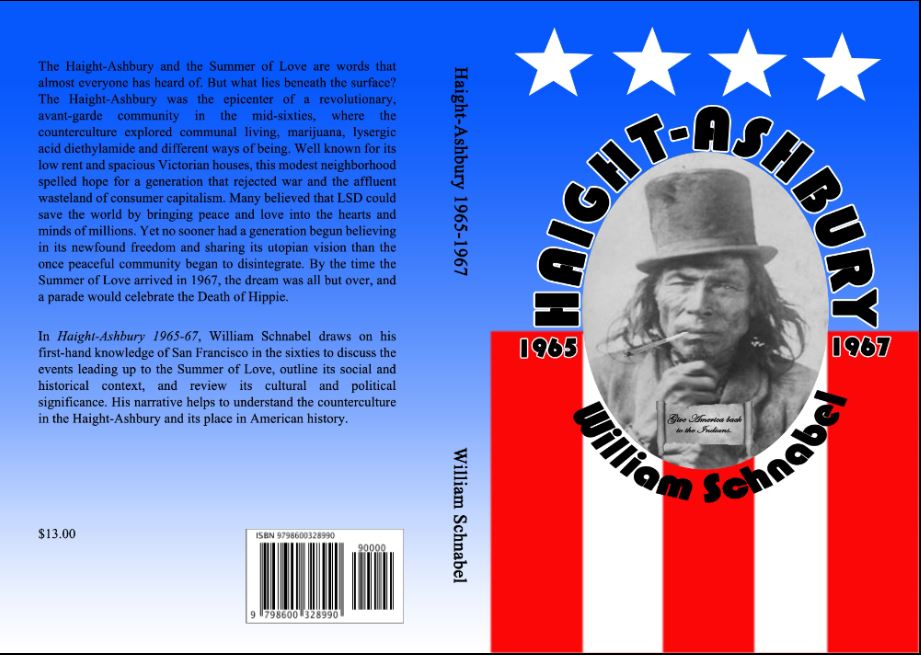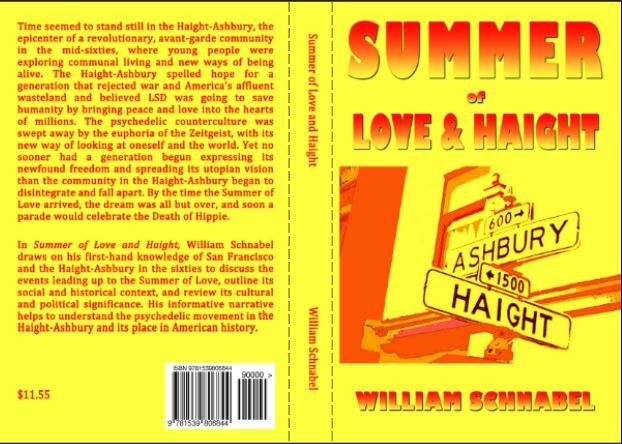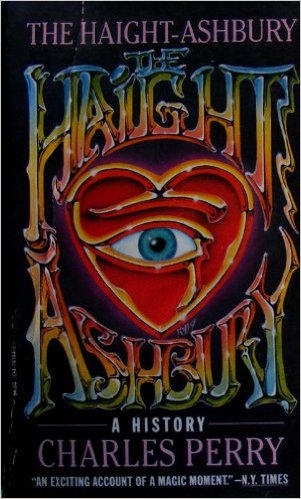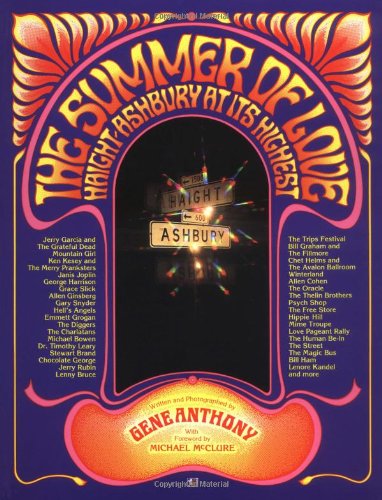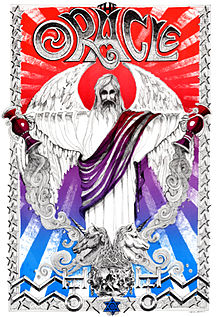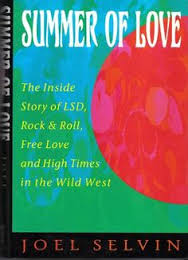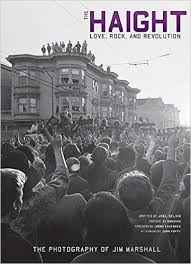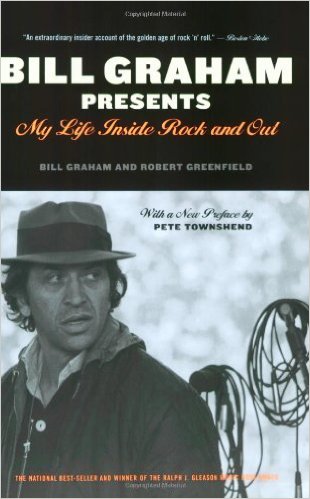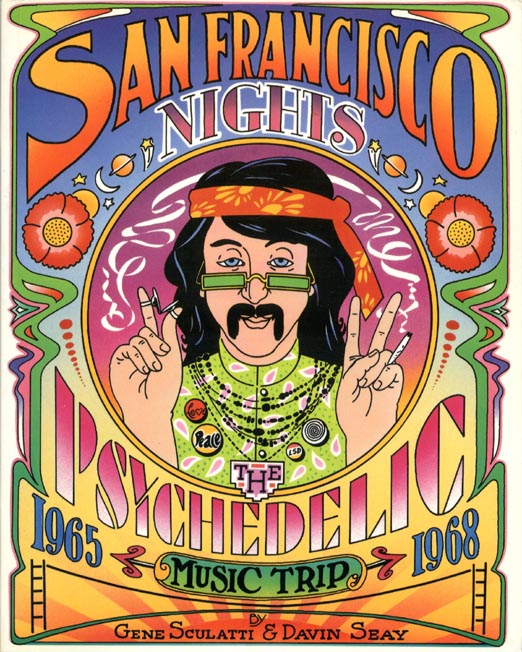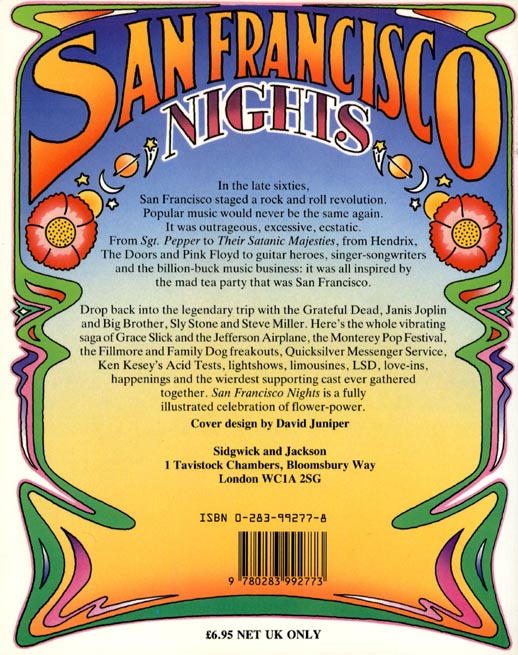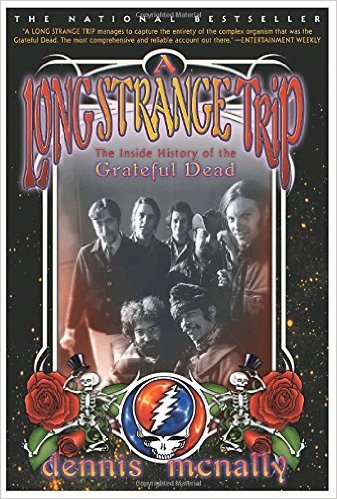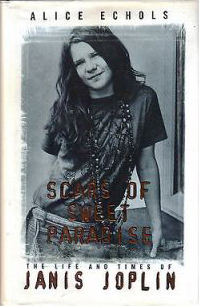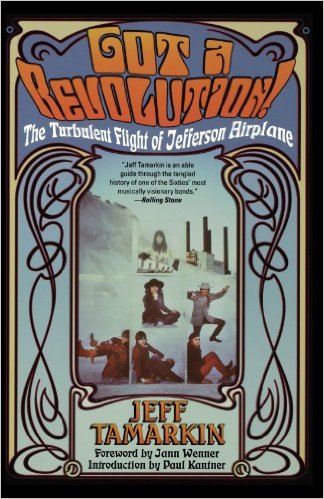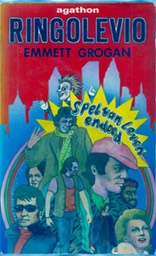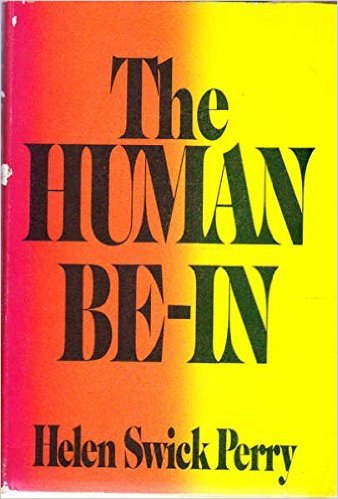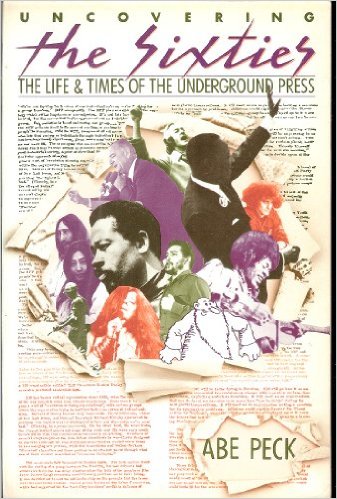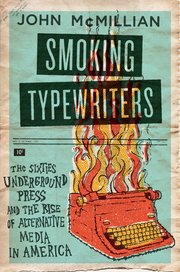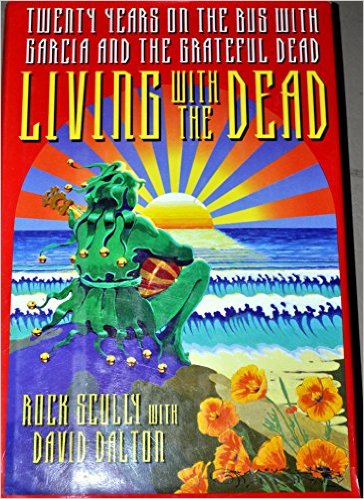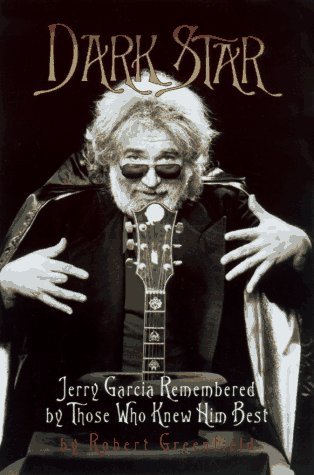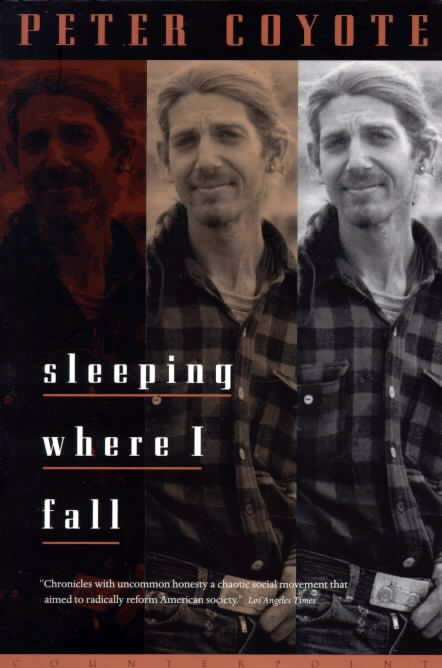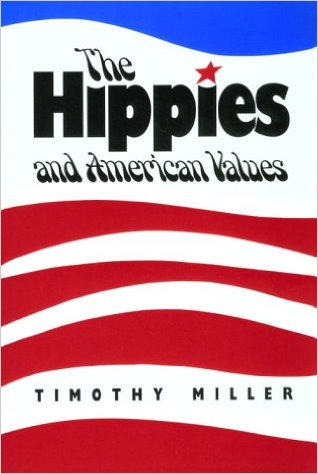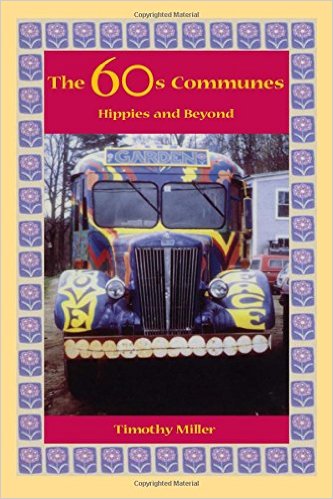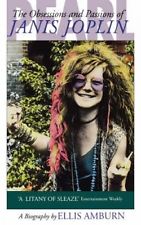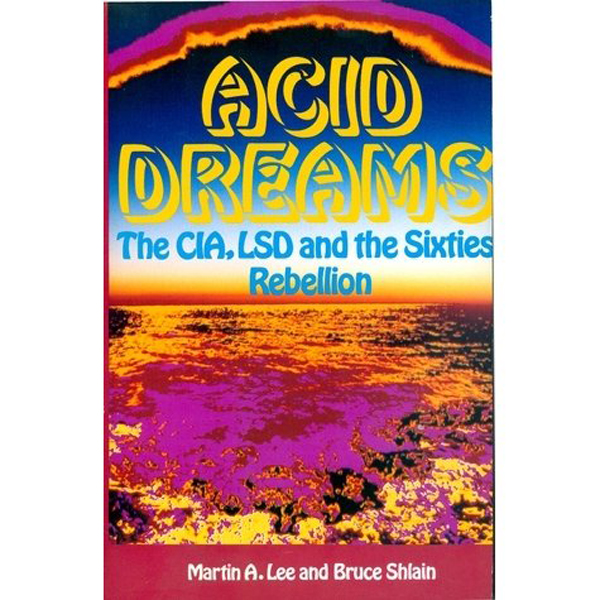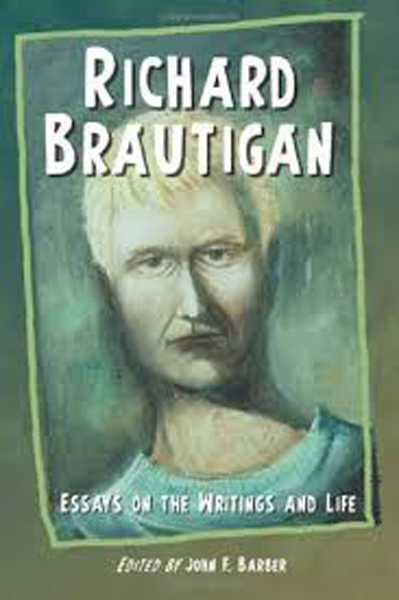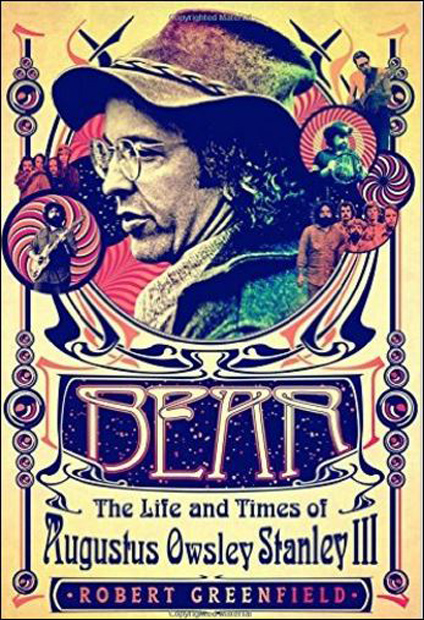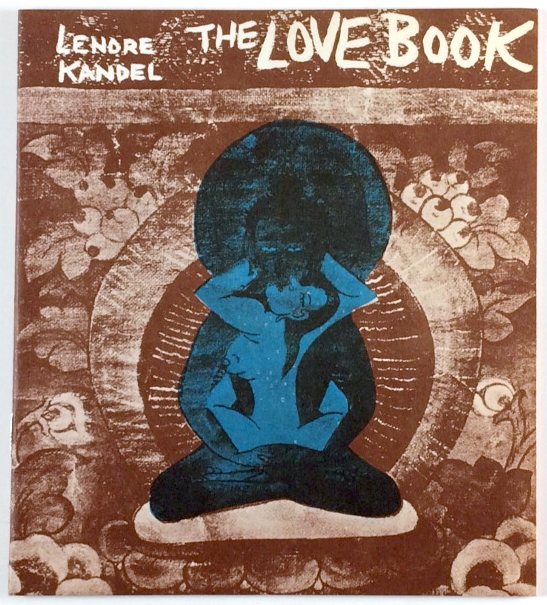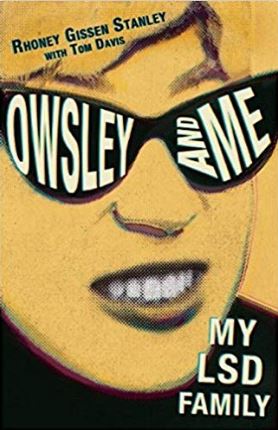Bibliography
Bibliography
This bibliography is intended to help readers choose books about the Summer of Love. There are, in fact, few books devoted exclusively to the event that occurred in the Haight-Ashbury district of San Francisco in the summer of 1967. Those are the texts by Charles Perry, William Schnabel, Joel Selvin and Gene Anthony. Because of the very nature of the subject, it is necessary to go beyond the summer of 1967 and study the events and tribal gatherings leading up to it, namely The Trips Festival, the Love Pageant Rally, the Human Be-In and the Monterey Pop Festival, because they captured the social zeitgeist of the time. It was an ephemeral period, lasting less than two years, and seemed to come abruptly to a halt. Several of the books listed below deal with certain aspects of the psychedelic counterculture, even though they are not specifically about the Summer of Love. They do, however, give useful information about a surprizingly complex social phenomenon. Although there have been anniversary celebrations that attempted to recapture the original spirit, the Summer of Love was a unique social movement and cannot be artificially reproduced.
The Haight-Ashbury and the Summer of Love are words that almost everyone has heard of. But what lies beneath the surface? The Haight-Ashbury was the epicenter of a revolutionary, avant-garde community in the mid-sixties, where the counterculture explored communal living, marijuana, lysergic acid diethylamide and different ways of being. Well known for its low rent and spacious Victorian houses, this modest neighborhood spelled hope for a generation that rejected war and the affluent wasteland of consumer capitalism. Many believed that LSD could save the world by bringing peace and love into the hearts and minds of millions. Yet no sooner had a generation begun believing in its newfound freedom and sharing its utopian vision than the once peaceful community began to disintegrate. By the time the Summer of Love arrived in 1967, the dream was all but over, and a parade would celebrate the Death of Hippie.Haight-Ashbury 1965-67 discusses the major events leading up to the Summer of Love, outlines the social and historical context and reviews the cultural significance of the period.
Title: Haight-Ashbury 1965-1967
Author: William Schnabel
Paperback: 358 pages
Publisher: Le Diable Ermite (January 17, 2020)
Language: English
First edition
ISBN-13: 979-8600328990
ASIN: B083XV6RPR
Product Dimensions: 5.2 x 0.9 x 8 inches
Shipping Weight: 1.1 pounds
Copyright © 2016, 17 January 2020 William Schnabel
This book was previously published under the title:
Summer of Love and Haight. 50th Anniversary of the Summer of Love
without the chapter on poster art, or the preface.
Different parts of the original text have been modified.
All rights reserved. No part of this book may be reproduced in any form or by any electronic or mechanical means without permission in writing from the publisher, except in the case of brief passages in
reviews and critical articles.
Library of Congress Cataloging–in–Publication Data
Schnabel, William.
Haight-Ashbury 1965-1967
Includes preface, index and bibliography
1. Haight-Ashbury–History–Twentieth century. 2. Summer of Love–San Francisco–1967. 3. Counterculture–History–Sociology–USA.
4. Rock music–San Francisco. 6. Be-In–History–San Francisco.
7. Underground press–San Francisco. 8. Lysergic acid diethylamide–History. 9. Rock posters–History–San Francisco.
ISBN-13: 979-8600328990
Book and cover design by Le Diable Ermite
Composition by Le Diable Ermite
Published in France by:
Le Diable Ermite
16 La Petite Rue
55140 Brixey-aux-Chanoines
https://le-diable-ermite.blog4ever.xyz/
Summer of Love & Haight USA Summer of Love & Haight UK Summer of Love & Haight FR
Schnabel, William. Summer of Love and Haight. 50th Anniversary of the Summer of Love. Le Diable Ermite, 3 December 2016, 314 pp.
Back cover
Time seemed to stand still in the Haight-Ashbury, the epicenter of a revolutionary, avant-garde community in the mid-sixties, where young people were exploring communal living and new ways of being alive. The Haight-Ashbury spelled hope for a generation that rejected war and America’s affluent wasteland, and that believed LSD was going to save humanity by bringing peace and love into the hearts of millions. The psychedelic counterculture was swept away by the euphoria of the zeitgeist, with its new way of looking at oneself and the world. Yet no sooner had a generation begun expressing its newfound freedom and spreading its utopian vision, than the community in the Haight-Ashbury began to disintegrate and fall apart. By the time the Summer of Love arrived, the dream was all but over and soon a parade would celebrate the Death of Hippie.
In Summer of Love and Haight, William Schnabel draws on his first-hand knowledge of San Francisco and the Haight-Ashbury in the sixties to discuss the events leading up to the Summer of Love, outline its social and historical context, and review its cultural and political significance. His informative narrative helps to understand the psychedelic movement in the Haight-Ashbury and its place in American history.
Summer of Love and Haight covers a wide range of topics, including the Love Pageant Rally, the Human Be-In, the Houseboat Summit, The Invisible Circus, The Monterey Pop Festival, the Diggers, the Communication Company, The Monterey International Pop Festival, The San Francisco Oracle, the San Francisco Music Scene, and Lysergic Acid Diethylamide (LSD). It discusses the events of the Summer of Love and the people involved in it, such as the many dance concerts at the Fillmore and the Avalon Ballroom, The Trips Festival, the Death of Money, and the people that either directly, or indirectly, made it all happen: Chet Helms, Bill Graham, Owsley Stanley, Allen Cohen, Michael Bowen, Ken Kesey, Timothy Leary and a host of others. The book includes an extensive bibliography and index. The text is not cramped on the page, either, so it's easier to read. This is a must for anyone interested in knowing what the Summer of Love was really about, and the book does not give a watered down version of the events. The historical and sociological analysis is not the kind you'll find in the mainstream press that often gets cold feet when it comes to revealing the plain truth. The author was born in California, grew up in the San Francisco Bay Area, and lived in the Haight-Ashbury in the sixties, so he knows the topic pretty well.
Amazon customer. In November 2009 I expanded my mind for the first time as a junior in high school and quickly became fascinated with the culture and music associated with said "consciousness expansion". I enveloped myself in the psychedelic genres of music that first became mainstream in the 1960s (which goes without saying) and so started with things like Rubber Soul, Revolver and Sgt. Pepper, and moved into things like Strawberry Alarm Clock, The Door, Jefferson Airplane and Creedence Clearwater Revival (among many others).
So, When I first visited Haight-Ashbury in July 2010, I was in paradise just to be surrounded by all this history, see the psychedelia and feel like I was seeing the remnants and being a small part of that crazy, world-changing experiment that happened those 43 years ago. I was a naive high school history and politics nerd who had a habit of romanticizing the past and wearing rose-colored Lennon glasses.
After 4 years at UC Santa Cruz (where I saw what modern hippies looked like and the spark the movement had lost) and another 3 years of working full-time and being a cog in the capitalist machine, I figured there had to be some stuff out there celebrating or at least acknowledging the 50th anniversary of this strange, sunny, flowery time in history. I was no longer naive enough to believe the "Summer of Love" on Haight Street was the idyllic paradise it was intended to be or that its goals were quashed merely by the outside, establishment forces that so resented it, and I thought this book would be a perfect source of edification for my stringing fascination with this period in history.
Boy was I right. Schnabel could not have done a better job writing a wholly readable, entertaining, honest and interesting account of these years. The chapters of the book perfectly split the content into sensible events and groups to cover and follow in a very coherent chronological order while still allowing room for overlap with other events and groups and themes throughout the brief 10 to 12 months the book hones in on.
The Summer of Love and Haight could have been a dry, esoteric account of a historical time period that, despite the excitement that lived behind it, had sociological issues galore to address. Rather, in less than 230 pages, Schnabel wittily and efficiently lays out a coherent timeline of events, brings in all the important figures and sufficiently introduces the reader to them, and works in the most interesting and delightfully trivial tidbits of lost, but not so long-gone history into the mix. He helped me painlessly reconcile my romantic alteralgic ideas about the era with the inevitable problems the Summer of Love faced because of the variety of different political, commercial and ideological interests that pervaded it and eventually spelled its downfall.
Perry, Charles. The Haight-Ashbury; A History. New York: Vintage Books, 1985, 308 pp.
2017 marks the 40th anniversary of San Francisco’s Haight-Ashbury district. The psychedelic community was probably the most widely written-about phenomenon of the 1960s apart from the Vietnam War. As unexpected as it was inevitable, the whole event from public manifestation to collapse happened in less than two years. In this acclaimed work, Charles Perry examines the history, the drama, and the energy of counterculture’s defining moment. First published by Rolling Stone Press in 1984, then by Vintage Books in 1985, it has been republished with a new introduction by the Grateful Dead’s Bob Weir. Perry’s highly acclaimed work is a must read for anyone interested in the events of the Haight-Ashbury. The book includes an index, but no bibliography. The cover of the paperback edition is by Alton Kelly, the artist who designed posters for the dance-concerts in San Francisco.
Gene Anthony Gene Anthony website
Anthony, Gene. The Summer of Love: Haight-Ashbury at its Highest. Milbrae, California: Celestial Arts, 1980, 184 pp.
Gene Anthony was a photography, so this large format book has many interesting photographs of the sixties, but it also has an informative text that gives details about the significant events leading up to the summer of love. Please note that the book is 10.8 x 8.4 inches. This book is interesting and highly useful to anyone studying the period.
Cohen, Allen, ed. The San Francisco Oracle, Facsimile Edition. Berkeley, California: Regent Press, 1991, 386 pp.
A remarkable book, in large format, including all twelve issues of the original San Francisco Oracle, plus P.O. Frisco, “Recollections,” and “A Brief History” by Allen Cohen, editor of the paper. The book is an artefact of the Haight-Ashbury.
"A complete copy of the legendary psychedelic underground newspaper originally published in the Haight Ashbury during the Summer of Love The San Francisco Oracle, published in the Haight Ashbury from 1966 to 1968, was one of the most unique and beautiful publications of the '60s. It is remembered for its extraordinary graphic design by major San Francisco artists, its rainbow colors and the cultural explorations and breakthroughs in its articles, interviews and poetry. This book contains each and every page of all 12 issues printed – in all their original brilliance “If the New Age Movement is a religion, these idealistic explorations into the personal experience and social implications of ‘mind expansion’ are part of its cannon. From the Aquarian Age to Native American shamanism, Eastern mysticism, communal living, utopian revolution, sexual liberation, ecological awareness and the socio-spiritual implications of LSD, The Oracle provides source documents of an eclectic spirituality and social philosophy that continue to exert a widespread – albeit subtle – influence on American society.”
A remarkable book, in large format, including all twelve issues of the original San Francisco Oracle, plus P.O. Frisco, “Recollections,” and “A Brief History” by Allen Cohen, editor of the paper. The book is an artefact of the Haight-Ashbury.
Selvin, Joel. Summer of Love: The Inside Story of LSD, Free Love and High Times in the Wild West. New York: Dutton, 1994, 376 pp.
Selvin's remarkable book covers the period from the summer of 1965 to the summer of 1971. The book is full of useful information on the period, but, paradoxically, there is no chapter on the summer of 1967. A good read, a classic on the period.
From Publishers Weekly
"Selvin ( Monterey Pop ) brings an astonishing amount of anecdotal detail to his history of the late 1960s and early '70s drug and musical scene of hippiedom's hippest city. "The so-called Summer of Love left San Francisco a mess," he notes, but promoter Bill Graham choreographed now-legendary concerts and events there that created a number of stars. For musical acts like the Grateful Dead, success arrived despite the pervasive drug abuse that Selvin describes; the Charlatans and Moby Grape, on the other hand, self-destructed. Selvin's exhaustive supply of anecdotes, however, proves to be his greatest liability, as well as his greatest resource, for he recites every vignette in the same laconic tone, giving his account a plodding pace that contradicts the frenzy of the era. Ultimately, the book, although suffused with a wealth of information, fails to resuscitate its mythic past. Photos not seen by PW."
Selvin, Joel. The Haight: Love, Rock and Revolution. Insight, 2014, 304 pp.
“This gorgeous oversized book documents the era through iconic images—the Beatles at Candlestick Park in '66, the Grateful Dead at a mobbed street fair in '68, Hendrix torching his guitar at Monterey Pop. Just as illuminating are verité shots of street life, hippies and straights rubbing wary shoulders as the Age of Aquarius, for a magic moment, dawned over them all.” —Rolling Stone, named one of 10 Best Music Books of 2014
Graham, Bill and Robert Greenfield. Bill Graham Presents. New York: Doubleday, 1992, 568 pp.
An informative and interesting book based on the structure of interviews. Many, many speakers in the book, so you get it right from the horse's mouth. Including Rock Scully, Ken Kesey, Jerry Garcia, Peter Coyote, Eric Clapton, Grace Slick, et al.
Sculatti, Gene and Davin Seay. San Francisco Nights. The Psychedelic Music Trip 1965-1968. London: Sidgwick and Jackson, 1985, 192 pp.
McNally, Dennis. A Long Strange Trip. The Inside History of the Grateful Dead. New York: Broadway Books, 2002, 684 pp.
"No other book on us comes close to it." –Bob Weir
Echols, Alice. Scars of Sweet Paradise. The Life and Times of Janis Joplin. London: Virago Press, 2001, 408 pp.
An honest, straightforward biography that gives useful information about Big Brother and the Holding Company, too.
"Janis Joplin was the skyrocket chick of the sixties, the woman who broke into the boys' club of rock and out of the stifling good-girl femininity of postwar America. With her incredible wall-of-sound vocals, Joplin was the voice of a generation, and when she OD'd on heroin in October 1970, a generation's dreams crashed and burned with her. Alice Echols pushes past the legary Joplin-the red-hot mama of her own invention-as well as the familiar portrait of the screwed-up star victimized by the era she symbolized, to examine the roots of Joplin's muscianship and explore a generation's experiment with high-risk living and the terrible price it exacted." (From Goodreads)
Tamarkin, Jeff. Got a Revolution! The Turbulent Flight of the Jefferson Airplane. New York: Atria, 2005., 410 pp
The most successful and influential rock band to emerge from San Francisco during the 1960s, Jefferson Airplane created the sound of a generation. Their smash hits "Somebody to Love" and "White Rabbit" virtually invented the era's signature pulsating psychedelic music and, during one of the most tumultuous times in American history, came to personify the decade's radical counterculture. In this groundbreaking biography of the band, veteran music writer and historian Jeff Tamarkin produces a portrait of the band like none that has come before it. Having worked closely with Jefferson Airplane for more than a decade, Tamarkin had unprecedented access to the band members, their families, friends, lovers, crew members, fellow musicians, cultural luminaries, even the highest-ranking politicians of the time. More than just a definitive history, Got a Revolution! is a rock legend unto itself.
Jann Wenner, editor-in-chief and publisher of Rolling Stone, wrote, "The classic [Jefferson] Airplane lineup were both architects and messengers of a psychedelic age, a liberation of mind and body that profoundly changed American art, politics, and spirituality. It was a renaissance that could only have been born in San Francisco, and the Airplane, more than any other band in town, spread the good news nationwide."
Grogan, Emmett. Ringolevio. Frogmore, St. Albans: Panther, 1976, 576 pp.
Ringolevio is a classic American story of self-invention by one of the more mysterious and alluring figures to emerge in the 1960s. Emmett Grogan grew up on New York City’s mean streets, getting hooked on heroin before he was in his teens, kicking the habit and winning a scholarship to a swanky Manhattan private school, pursuing a highly profitable sideline as a Park Avenue burglar, then skipping town to enjoy the dolce vita in Italy. It’s a hard-boiled, sometimes hard-to-believe, wildly entertaining tale that takes a totally unexpected turn when Grogan washes up in sixties San Francisco and becomes a leader of the anarchist group known as the Diggers. The Diggers, devoted to street theater, direct action, and distributing free food, were in the thick of the legendary Summer of Love, and soon Grogan is struggling with the naive narcissism of the hippies, the marketing of revolution as a brand, dogmatic radicals, and false prophets like tripster Timothy Leary. Above all, however, he struggles with himself.
Ringolevio is an enigmatic portrait of a man and his times to set beside Hunter S. Thompson’s stories of fear and loathing, Norman Mailer’s The Armies of the Night, or the recent Chronicles of Bob Dylan, who dedicated his 1978 album Street Legal to the memory of Emmett Grogan.
NB This text refers to the paperback edition.
Perry, Helen S. The Human Be-In. New York: Basic Books, 1970, 246 pp.
The title may be a little misleading because the book is not just about the Human Be-In in San Francisco, but also about the Haight-Ashbury, hippies, the Fillmore districts, and about young people in the sixties. Interesting.
Peck, Abe. Uncovering the Sixties. The Life and Times of the Underground Press. New York: Pantheon, 1985, 366 pp.
This book is not about the Haight-Ashbury, but it gives useful information about the counterculture of the sixties and the underground press.
McMillian, John. Smoking Typewriters. New York: Oxford University Press, 2011, 278 pp .
How did the New Left uprising of the 1960s happen? What caused millions of young people-many of them affluent and college educated-to suddenly decide that American society needed to be completely overhauled?
In Smoking Typewriters, historian John McMillian shows that one answer to these questions can be found in the emergence of a dynamic underground press in the 1960s. Following the lead of papers like the Los Angeles Free Press, the East Village Other, and the Berkeley Barb, young people across the country launched hundreds of mimeographed pamphlets and flyers, small press magazines, and underground newspapers. New, cheaper printing technologies democratized the publishing process and by the decade's end the combined circulation of underground papers stretched into the millions. Though not technically illegal, these papers were often genuinely subversive, and many of those who produced and sold them-on street-corners, at poetry readings, gallery openings, and coffeehouses-became targets of harassment from local and federal authorities. With writers who actively participated in the events they described, underground newspapers captured the zeitgeist of the '60s, speaking directly to their readers, and reflecting and magnifying the spirit of cultural and political protest. McMillian pays special attention to the ways underground newspapers fostered a sense of community and played a vital role in shaping the New Left's highly democratic "movement culture."
Scully, Rock with David Dalton. Living with the Dead. New York: Little, Brown & Co., 1996, 382 pp.
An intimate portrait of the Grateful Dead.
Greenfield, Robert. Dark Star. An Oral Biography of Jerry Garcia. New York William Morrow, 1996, 374 pp.
For more than thirty years, Jerry Garcia was the musical and spiritual center of the Grateful Dead, one of the most popular rock bands of all time. In Dark Star, the first biography of Garcia published after his death, Garcia is remembered by those who knew him best. Together the voices in this oral biography explore his remarkable life: his childhood in San Francisco; the formation of his musical identity; the Dead's road to rock stardom; and his final, crushing addiction to heroin. Interviews with Jerry's former wives, lovers, family members, close friends, musical partners, and cultural cohorts create a behind-the-scenes look at the making of a rock-and-roll icon—and at the price of fame.
Coyote, Peter. Sleeping Where I Fall. Washington D.C.: Counterpoint, 1998, 368 pp.
In his energetic, funny, and intelligent memoir, Peter Coyote relives his fifteen-year ride through the heart of the counterculture—a journey that took him from the quiet rooms of privilege as the son of an East Coast stockbroker to the riotous life of political street theater and the self-imposed poverty of the West Coast communal movement known as The Diggers. With this innovative collective of artist-anarchists who had assumed as their task nothing less than the re-creation of the nation’s political and social soul, Coyote and his companions soon became power players. In prose both graphic and unsentimental, Coyote reveals the corrosive side of love that was once called “free”; the anxieties and occasional terrors of late-night, drug-fueled visits of biker gangs looking to party; and his own quest for the next high. His road through revolution brought him to adulthood and to his major role as a political strategist: from radical communard to the chairman of the California Arts Council, from a street theater apprentice to a motion-picture star. (From Amazon)
Miller, Timothy. The Hippies and American Values. Knoxville, Tenn.: University of Tennessee, 1991, 182 pp.
“Turn on, tune in, drop out,” Timothy Leary advised young people in the 1960s. And many did, creating a counterculture built on drugs, rock music, sexual liberation, and communal living. The hippies preached free love, promoted flower power, and cautioned against trusting anyone over thirty. Eschewing money, materialism, and politics, they repudiated the mainstream values of the times. Along the way, these counterculturists created a lasting legacy and inspired long-lasting social changes.
The Hippies and American Values uses an innovative approach to exploring the tenets of the counterculture movement. Rather than relying on interviews conducted years after the fact, Timothy Miller uses “underground” newspapers published at the time to provide a full and in-depth exploration. This reliance on primary sources brings an immediacy and vibrancy rarely seen in other studies of the period.
Miller focuses primarily on the cultural revolutionaries rather than on the political radicals of the New Left. It examines the hippies’ ethics of dope, sex, rock, community, and cultural opposition and surveys their effects on current American values. Filled with illustrations from alternative publications, along with posters, cartoons, and photographs, The Hippies and American Values provides a graphic look at America in the 1960s.
This second edition features a new introduction and a thoroughly updated, well-documented text. Highly readable and engaging, this volume brings deep insight to the counterculture movement and the ways it changed America. The first edition became a widely used course-adoption favorite, and scholars and students of the 1960s will welcome the second edition of this thought-provoking book.
Miller, Timothy. The 60s Communes. Hippies and Beyond. New York: Syracuse University Press, 1999, 330 pp.
The greatest wave of communal living in American history crested in the tumultuous 1960s era including the early 1970s. To the fascination and amusement of more decorous citizens, hundreds of thousands of mostly young dreamers set out to build a new culture apart from the established society. Widely believed by the larger public to be sinks of drug-ridden sexual immorality, the communes both intrigued and repelled the American people. The intentional communities of the 1960s era were far more diverse than the stereotype of the hippie commune would suggest. A great many of them were religious in basis, stressing spiritual seeking and disciplined lifestyles. Others were founded on secular visions of a better society. Hundreds of them became so stable that they survive today. This book surveys the broad sweep of this great social yearning from the first portents of a new type of communitarianism in the early 1960s through the waning of the movement in the mid-1970s. Based on more than five hundred interviews conducted for the 60s Communes Project, among other sources, it preserves a colorful and vigorous episode in American history. The book includes an extensive directory of active and non-active communes, complete with dates of origin and dissolution.
Amburn, Ellis. Pearl: The Obsessions and Passions of Janis Joplin. New York: Time Warner, 1992, 340 pp.
Out of the Texas-Louisiana swamps she wailed the blues like no one, black or white, has ever dared. She was Janis Joplin--the first rock star of the 1960s counterculture, a fashion trendsetter in San Francisco's back-to-the-roots movement that overtook the world, a prisoner of an ultimately doomed search for happiness in sex and drugs, money and fame. (From Amazon)
Lee, Martin A. and Bruce Shlain. Acid Dreams. Grove Press, revised edition 1994, 384 pp.
Few events have had a more profound impact on the social and cultural upheavals of the Sixties than the psychedelic revolution spawned by the spread of LSD. This book for the first time tells the full and astounding story—part of it hidden till now in secret Government files—of the role the mind-altering drug played in our recent turbulent history and the continuing influence it has on our time.
And what a story it is, beginning with LSD’s discovery in 1943 as the most potent drug known to science until it spilled into public view some twenty years later to set the stage for one of the great ideological wars of the decade. In the intervening years the CIA had launched a massive covert research program in the hope that LSD would serve as an espionage weapon, psychiatric pioneers came to believe that acid would shed light on the perplexing problems of mental illness, and a new generation of writers and artists had given birth to the LSD sub-culture.
Acid Dreams is a complete social history of the psychedelic counter-culture that burst into full view in the Sixties. With new information obtained through the Freedom of Information Act, the authors reveal how the CIA became obsessed with LSD during the Cold War, fearing the Soviets had designs on it as well. What follows is one of the more bizarre episodes in the covert history of U.S. intelligence as the search for a “truth drug” began to resemble a James Bond scenario in which agents spied on drug-addicted prostitutes through two-way mirrors and countless unwitting citizens received acid with sometimes tragic results.
The story took a new turn when Captain Al Hubbard, the first of a series of “Johnny Appleseeds” of acid, began to turn on thousands of scientists, businessmen, church figures, policemen, and others from different walks of life.
Timothy Leary, Ken Kesey and his band of Merry Pranksters, Allen Ginsberg and the Beat generation, the Diggers and the Age of Golden Anarchy in Haight-Ashbury, William Mellon Hitchcock, Abbie Hoffman and the Yippies, the Beatles—these are just some of a motley cast of characters who stride through the pages of this compelling chronicle. What impact did the widespread use of LSD have on the anti-war movement of the late Sixties? Acid Dreams traces the way the drug intensified each stage of counter-cultural transition to break the “mind-forged manacles” of a new generation in rebellion.
In Acid Dreams, Martin Lee and Bruce Shalin have written the history of a time still only dimly understood. The events they recount and the facts they uncover supply an important missing piece of the puzzle of a crucial decade in our recent past.
Barber, John. Richard Brautigan. McFarland and Co., 2006, 314 pp.
Best known for his novel Trout Fishing in America, American writer Richard Gary Brautigan (1935-1984) published eleven novels, ten poetry collections, and two story collections, as well as five volumes of collected work, several nonfiction essays, and a record album of spoken voice recordings. Brautigan s idiosyncratic style and humor caused him to be identified with the counterculture movement of the 1960s. The authors of many of these 32 essays knew Brautigan personally and professionally; others came to know and respect him through a cultivated connection with his writings. The essays-many of which are new, others of which were published in obscure journals-combine personal remembrance of the man and critical appraisal of his still-controversial works. Includes previously unpublished photographs and artworks. (From Amazon)
Greenfield, Robert. Bear. The Life and Times of Augustus Owsley Stanley III. St. Martin's Press, 1 Dec. 2016, 288 pp.
[From Amazon] “[Augustus Owsley Stanley III] was Walter White without all the moral conflict or drama, a trailblazing alchemist who mass-produced LSD and made millions before anyone thought to make it illegal. Bear remains interesting long after his era has passed… Essential for Deadheads but also an engaging cultural portrait for anyone interested in the era.”―Kirkus Reviews
"The most mysterious man of the underground is finally revealed. Who changed life in the 20th century more than Owsley, who made the first million or so doses of LSD? He spent his life covering his tracks, avoiding photographs and spreading misinformation about himself, but now, finally, Robert Greenfield's Bear: The Life and Times of Augustus Stanley Owsley gives us the man and his great life in all its considerable glory."―Joel Selvin, author of Altamont: The Rolling Stones, the Hells Angels and Rock's Darkest Day
“Like Bill Graham and Jerry Garcia before him, Owsley Stanley comes alive on the page thanks to Robert Greenfield’s incisive ability to dig deep and illuminate a crucial and elusive figure in American music and popular culture. Bear is an invaluable part of any self-respecting Deadheads’ library.”―Alan Paul, author of One Way Out: The Inside History of the Allman Brothers Band
"Robert Greenfield ably provides a sorely-needed sorting of the facts, myths, and deeply original beliefs originating from Owsley Stanley, father of American LSD and idiosyncratic patron to the Grateful Dead. A complex figure of unparalleled importance in the counterculture―and, thus, 20th century history at large--the rarely interviewed or photographed chemist comes alive on his own Owsleyian terms while Greenfield clears up the untruths and sets a few new legends in motion."―Jesse Jarnow, author of Heads: A Biography of Psychedelic America
"Owsley “Bear” Stanley was an authentic shaman-alchemist whose production of millions of doses of LSD transformed a tiny San Francisco neighborhood into ground zero for a planet-wide challenge to conventional notions of reality. That he was also ornery, obsessive, and at times just plain odd was merely part of the package. Bear illuminates a fascinating story with insight and panache, and it’s essential -- no Owsley, no sixties as we know them; it’s that simple".―Dennis McNally, author of A Long Strange Trip and On Highway 61
"Perfectly in line with his insightful biographies of Jerry Garcia and Timothy Leary, Robert Greenfield’s Bear paints a rich portrait of yet another counterculture icon, the legendary and ever-mysterious Owsley Stanley. Bolstered by Greenfield’s revealing interviews with his late subject, Bear proves Owsley was more than just the “King of LSD.” From sound systems to climate change, he was the forward-thinking Renaissance Man of the psychedelic era, and here, at last, is his full, fascinating story."―David Browne, author of So Many Roads: The Life and Times of the Grateful Dead
"[T]he first full biography of the man whose obsessive drive for perfection gave the [Grateful] Dead their dedication to quality in their performances and recordings....Greenfield's anecdotal Bear feeds a Deadhead's jones―those who were there during that Summer of Love or their children and grandchildren. Robert Greenfield's gossipy Bear captures the genius and craziness of the man who turned on a generation and made the Grateful Dead into a rock powerhouse."―Shelf Awareness
“. . . a poignant glimpse of a man with extraordinary power who ultimately used that power against himself.”―Boston Globe on Dark Star
“The best book ever written about the Stones, if not music in general.”―Independent on S.t.p.: A Journey Through America With The Rolling Stones
"The LSD made by the man we called Bear was some of the best. His influence is immeasurable. Robert Greenfield does a damn good job of telling us why that is so."―Counter Punch
Kandel, Lenore. The Love Book. Stolen Paper Editions, 1966.
It is amazing to think that a book that is only 6 pages long and only contains 4 poems could spark such a firestorm of controversy. In 1966 the books were seized and that author printers and sellers.In November 1966 police raided the City Lights Bookstore and the Psychedelic Shop. They impounded her book on the grounds that it "excited lewd thoughts". For the future governor of California, Ronald Reagan, running on a ticket about cleaning up society, Kandel's book was a stick with which to beat the Bay Area's burgeoning hippie scene. The bust led to one of the city's longest-running court cases, going on appeal to the California Supreme Court, which upheld the obscenity ruling. In The San Francisco Poetry Renaissance, 1955-1960 (1991) Warren French called it the city police's "last highly publicized case of attempted censorship". A federal court finally overturned the prosecution in 1974. The Love Book was lost until this reprint was mad available. The history behind book is probably more important than the actual content. It is a must have for anyone truly interested in 1960's hippie literature. (From Amazon.com)
(From Amazon) Owsley and Me is a love story set against the background of the Psychedelic Revolution of the '60s. Owsley "Bear" Stanley met her in Berkeley in 1965, when LSD was still legal and he was the world's largest producer and distributor of LSD. Rhoney found herself working in an LSD laboratory, and the third corner in a love triangle. We all know the stories from the '60s—but never from the point of view of a woman finding her way through twisted trails of love, jealousy, and paranoia, all the while personally connecting to the most iconic events and people of her time.
Bear supported the Grateful Dead in their early years and gave away as much LSD as he sold—millions of hits. He designed and engineered the infamous Wall of Sound system of the early '70s, just before he began his two years in prison, with Rhoney raising their infant son. He died one year ago, but the era he helped create is now being rediscovered by a new generation interested in the meaning of it all.
Today Rhoney Stanley is a practicing holistic orthodontist in Woodstock, New York. This is her first book.
Tom Davis was an Emmy Award–winning American writer and comedian. He is best known for being one of the original writers for Saturday Night Live and for his former partnership with Al Franken, as half of the comedy duo "Franken & Davis." His memoir Thirty-Nine Years of Short-Term Memory Loss: The Early Days of SNL from Someone Who Was There was published in 2010 by Grove Press.
Rhoney Gissen met Owsley Bear Stanley in Berkeley, California, in 1965. In addition to being a sound engineer for the then-new rock band, the Grateful Dead, Bear made and sold lysergic acid diethylamide, otherwise known as LSD, which, at the time, was completely legal. But it soon wouldn’t be, and when the law changed, Bear became an outlaw, and Rhoney his willing accomplice. Her memoir is a story of love and experimentation. As someone who worked in the labs that produced LSD, Rhoney has firsthand knowledge of the environment surrounding the psychedelic drug in its heyday. Famous people—Timothy Leary, Jerry Garcia, Ravi Shankar, Jimi Hendrix, Ken Kesey—wander in and out of the story, which delivers a vivid, behind-the-scenes look at the 1960s counterculture. A nostalgia trip for many, to be sure, but also an involving love story that chronicles the sometimes turbulent relationship between Rhoney and Owsley. --David Pitt
“Owsley was a key 1960s figure, who some would say "turned on" a generation more so than even Tim Leary, but his own life has long been shrouded in mystery. Here's a firsthand recollection, as "intimate" as is likely to be penned…Here are firsthand backstage accounts of the Monterey Pop Festival, Woodstock, Altamont, and much more … with various Beatles, Stones, San Francisco musicians, of course, and other famed counterculture figures popping in and out.”--Huffington Post
“OWSLEY AND ME is totally geared toward people who have an interest in the music of the time, but also one of the most influential characters of all of drug culture. Think of it as the real BREAKING BAD, just with more peace and love, and a whole lot less guns and dead bodies.”--Bookgasm

